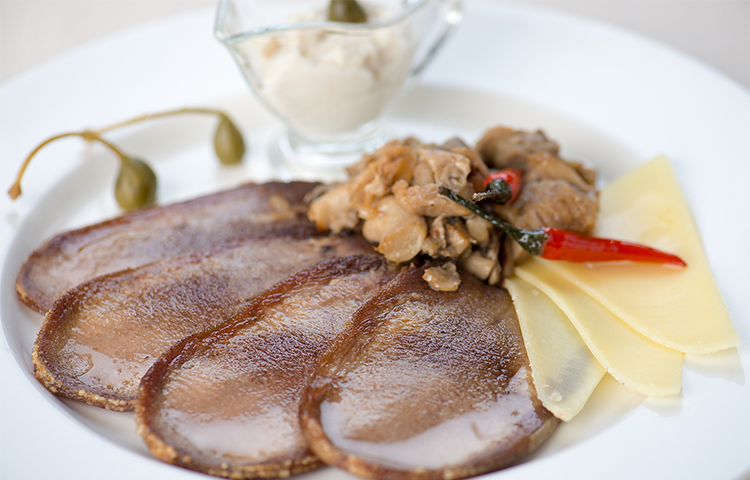Tibetan Steamed Yak Tongue: Jie Lang Zui Guide
Introduction
On the Tibetan Plateau—often called the Roof of the World—travelers encounter towering peaks, sacred lakes, and a living cultural heritage. They also discover unique highland flavors, among which steamed yak tongue, known in Tibetan as ‘Jie Lang Zui’, stands out. This tender, fragrant dish reflects nomadic resourcefulness and offers a direct taste of Tibetan culinary tradition. Below is a practical and cultural guide to appreciating this local specialty.
1. Origin and History: A Tribute to Pastoral Wisdom
Tibetan steamed yak tongue grew out of life on the harsh, high-altitude grasslands. Above 4,000 meters, yaks are essential to nomadic households—providing milk, meat, wool, and transport. Faced with limited resources, Tibetan people developed a cuisine that respects every part of an animal. Yak tongue, one of the most tender cuts, became a prized ingredient. Traditionally served at festivals or to honored guests, the simple steaming method preserves natural flavors and demonstrates hospitality passed down through generations.
2. Cultural Significance: A Dish of Honor
In Tibetan custom, serving steamed yak tongue is more than offering food: it’s a gesture of deep respect. Because each animal yields only one tongue, the ingredient is reserved for special occasions—Losar (Tibetan New Year), weddings, visits by respected lamas, or major family gatherings. Presenting the first slice to a guest symbolizes esteem and warmth, reflecting the Tibetan values of gratitude for nature’s gifts and generous hospitality.

3. Ingredients: Highland Gifts from the Yak
Authentic steamed yak tongue uses local, free-range yaks grazing on alpine meadows. These animals feed on native grasses and alpine herbs, producing lean, tender meat with a clean flavor and no noticeable gamey smell. A high-quality yak tongue is pale pink, firm yet springy, with fine muscle fibers. Local condiments—especially sun-dried Tibetan chili powder—complement the tongue’s richness without overpowering it.
4. Preparation: Simple Technique, Careful Timing
Although straightforward, preparing steamed yak tongue requires precise technique:
- Cleaning: Rub the fresh tongue with coarse salt to remove mucous, then rinse thoroughly in clean water.
- Slow simmering: Place the whole tongue in a pot, cover with cold water, and bring to a gentle simmer. After boiling, reduce to a very low simmer and cook 2–3 hours until tender.
- Peeling and slicing: Remove the tongue while hot and peel off the white outer membrane—this separates easily when cooked—revealing the tender, pink interior.
- Shaping and serving: Lightly press to set shape, then slice against the grain into thin pieces and arrange on a traditional wooden platter.
The minimal use of seasonings highlights the yak tongue’s natural taste and reflects Tibetan culinary restraint.

5. Flavor and Texture: A High-Plateau Delicacy
Steamed yak tongue delivers a delicate, silky texture. Its color ranges from pale grayish-pink with marbled grain. The first impression is remarkable tenderness—each slice almost melts under the tongue. The meat carries a mellow, slightly dairy-like aroma with subtle wild notes, but no strong gaminess. Paired with a dash of dried chili powder, the tongue’s full-bodied flavor becomes more vivid without losing its authenticity.
6. Ways to Eat: Tradition Meets Modern Variety
Traditional consumption is simple: dip thin tongue slices into Tibetan chili powder and savor the pure taste. Modern restaurants offer variations—served with pickled radish to cut richness, dressed with garlic and coriander, or reimagined in a tongue salad. At home in Tibetan households, steamed yak tongue often appears alongside tsampa (barley flour) and butter tea, forming a genuine highland feast. Hot, just-steamed tongue is always best.

7. Eating Advice: Tips for the Best Experience
To enjoy steamed yak tongue authentically, consider these tips:
- Best season: Autumn and winter are ideal—yaks are fattier and meat is richer then.
- Where to try: Look for traditional Tibetan restaurants around Lhasa’s Barkhor (Bharkhor) Street or reputable hotel Tibetan kitchens for reliable preparations.
- Drink pairings: Sweet butter tea or barley wine (chang) complement the tongue by softening spiciness and accentuating meat aroma.
- Portion guide: Order 100–150 grams per person as part of a multi-dish meal.
- Respect local custom: Accepting the first slice offered by a host is a polite, respectful gesture.
8. Traveler Tips: Practical High-Plateau Advice
- Altitude adjustment: Acclimatize in Lhasa for 1–2 days before consuming richer meats if you’re sensitive to altitude.
- Seek authenticity: Restaurants frequented by locals usually serve more traditional flavors.
- Price range: A 200-gram portion typically costs around RMB 60–120; prices may be higher in tourist zones.
- Language hint: Remember the Tibetan name ‘Jie Lang Zui’ when ordering for easier communication.
- Photo etiquette: Ask permission before photographing food in private homes or upscale venues.

9. Home Version: A Simple Recipe to Recreate the Taste
Ingredients: one beef or yak tongue, 3–4 slices of ginger, a pinch of Sichuan peppercorns (optional), salt to taste, and high-quality chili powder.


